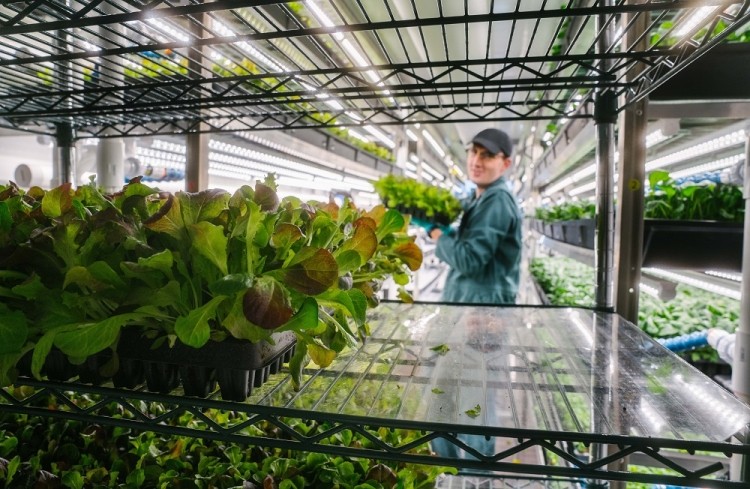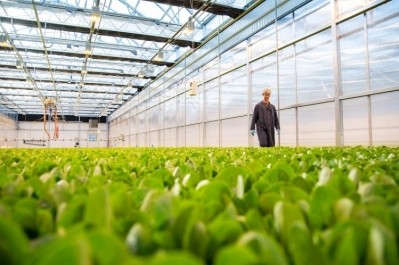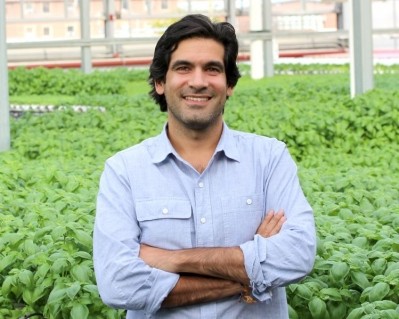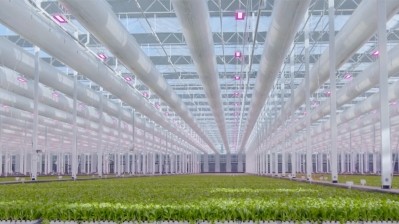Square Roots teams up with UNFI to expand access to locally-grown leafy greens: 'We have the shortest supply chain possible'

Scheduled to open in 2023, the new 20,000-square-foot Square Roots farm will be able to produce up to three million retail packages of salad mixes, microgreens, and herbs per year, serving retailers and consumers in the Twin Cities metro areas in Wisconsin and Minnesota.
The new farm will look similar to Square Roots other indoor farming locations throughout the Midwest, using the company's same ultra-efficient hydroponic system, which uses significantly less water and land than conventional field farms. Inside its farms, Square Roots’ farmers use the company’s proprietary software to manage every aspect of growing, from planning production tasks to monitoring plant health.
"In essence, we'll have grow zones where the plants are growing. Inside there you have controlled climates that are optimized for the plant growth and there'll be additional infrastructure on site that provides all the additional space that you need to run a food-safe and people-safe commercial scale operation (i.e. packing rooms. cold storage, bio-security)," Square Roots CEO Tobias Peggs told FoodNavigator-USA.
"The whole thing soup-to-nuts will be monitored and operated in part with the Square Roots operating systems software that we built. The whole idea really is through a combination of that hardware and software and then workflows through which you train the farmers is that we're able to get almost manufacturing-like levels of predictability and consistency out of this farm."
The agreement with UNFI includes plans for additional farms located on-site at other select UNFI distribution centers.
Power of co-location model
With the intent of reducing the number of 'food miles' fresh produce travels to reach the end consumer, indoor farms such as Square Roots have the potential to transform the current fresh food supply chain, noted Dorn Wenninger, senior vice president of produce at UNFI.
"Every day from the time you harvest until the consumer gets it in their home you're stealing days of freshness. Our goal at UNFI is how do we give those days of freshness back to the consumer," Wenninger told FoodNavigator-USA.
Square Roots produce harvested at the UNFI distribution center will reach stores within hours from the time that it's harvested creating a shorter, stronger supply chain.
"The last 24 months have taught us that we've seen empty shelves across the grocery store and we continue to today in certain categories. The shorter one's supply chain is the better surety of supply that you have. So you couldn't get any shorter [with the Square Roots and UNFI co-located]."
However, Wenninger noted the importance of strategically locating indoor farms, such as Square Roots, to have a maximum market impact.
"It's a fine line between what is the critical mass to allow the investment vs. the demand. While it's intellectually interesting to think about growing food at your local retail store, the reality is that local retail store is just one store," said Wenninger.
Whereas, Square Roots' co-location in Prescott, Wisc., where UNFI has two large distribution centers, will service hundreds of retail stores within a few-hours drive.
"You're achieving both of the best worlds where you have close proximity but you're also able to leverage the scale in producing 52 weeks, 365 days of the year while having access to a market where you can have efficient economies of scale yet still have the freshness aspect," added Wenninger.
Wenninger also noted the larger looming environmental picture which has impacted the supply of fresh produce.
"Right now, the United States is facing shortages on certain lettuces because of weather conditions and the costs are record high. One thing about CEA is that the farms produce the same amount every day. We're not concerned about the weather, we're not concerned about trucks because we have the shortest supply chain possible," said Wenninger.
Interested in the future of food and creating sustainable supply chains?
Register for our upcoming FREE-to-attend virtual summit: Futureproofing the Food System, November 15-17.


















